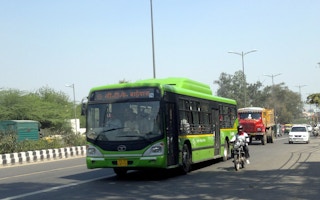Infamous as the world’s most polluted large city, Delhi took a small green step on October 22 when it launched its first ‘car-free day’, a campaign that saw a dramatic dip in pollution levels for a short while.
The campaign was led by Delhi Chief Minister Arvind Kejriwal, his deputy Manish Sisodia and other cabinet ministers, all of whom left their cars behind and rode bicycles instead in a city where air pollution allegedly kills one person every hour.
The bicycle rally that took off with the intent of motivating people to switch to environment-friendly cycles and public transport covered seven big traffic crossings on a six km stretch between Red Fort in the old city and Bhagwan Das Road in New Delhi for five hours in the morning.
According to the Centre for Science and Environment (CSE), the first car-free day was a big success. The think tank’s own monitoring indicated a 60 per cent drop in PM2.5 level.
These are small particulates below 2.5 microns in diameter, so they lodge deep in the lungs and cause many respiratory diseases. CSE said PM2.5 level on the car-free stretch dropped from 689 microgram per cubic metre to 265.
“This revolution is crucial because people are breathing in poisonous air. Cars have become a status symbol in Delhi and it is very important that people start understanding that life is more important than cars,” Delhi Transport Minister Gopal Rai told thethirdpole.net.
“We will be celebrating the 22nd of every month as car-free day from now,” Rai added. But that does not mean the entire metropolis will go car-free. It is an awareness drive that will be taken to different parts of the city. The next one will be in Dwarka, a sprawling sub city in south-west Delhi. “We are sure there will be a gradual shift,” Rai added.
The shift has not happened anywhere without good public transport. The minister said, “We are going to procure 2,000 new buses in the next six months. We have already done a lot of research and have even gone through international studies to see how we can have a more attractive, robust public transport system.”
The campaign, which follows a similar car-free day observed every Tuesday in the adjoining city Gurgaon, is crucial for a Delhi of 25 million people that has been exploding with private cars, directly impacting air quality.
The city already has 8.8 million vehicles and 1,400 new vehicles get added to its roads each day. In the last year alone, vehicle registration increased 14 per cent. Delhi has more vehicles than Mumbai, Kolkata and Chennai put together. The latest Economic Survey of Delhi (2014-15) shows that the number of cars has increased 2.7 times in 15 years.
Air pollution has been so bad, particularly in winter, that one in every three children in Delhi is suffering from impaired lungs, says a study.
A beginning
But a beginning towards a solution may well have been made. CSE’s observed reduction was supported by the city-wide official ambient air quality monitoring done by the Delhi Pollution Control Committee which showed an overall drop of 45 per cent in PM2.5 level in the city on October 22.
However, the drop in air pollution cannot be attributed to the awareness drive alone. October 22 was also a national holiday, so there were far fewer vehicles on the road anyway. The real effectiveness of the campaign will be seen in the coming months.
Experts have welcomed the initiative. Anumita Roychowdhury, CSE executive director (research and advocacy), said, “This initiative of the Delhi government has only helped to prove how the growing car numbers in Delhi aggravate toxic pollution; if these numbers are controlled, pollution can be lowered significantly.”
In a business-as-usual scenario, it has been estimated that by 2021, car ridership may increase by 106 per cent while bus ridership will increase only by 28 per cent.
Clearly, an awareness drive will not be enough. Roychowdhury said controlling pollution “will need simultaneous action to restrain car usage on a daily basis.” Other experts say the government needs to remove hidden subsidies on cars. Today, a bus owner pays nine times the road tax paid by a car owner.
One follow-up is an agreement between the Delhi Dialogue Commission (DDC) and the University of Chicago to focus on improving the capital’s air and water quality. It will include a competition – called Urban Labs Innovation Challenge Delhi – to build a toolkit of projects proposed by local institutions and tapping into grassroots expertise. The best ideas will be funded by the University of Chicago Urban Labs initiative.










